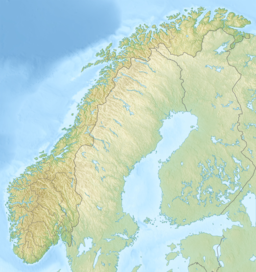| Lesjaskogsvatnet | |
|---|---|
 View of the northwestern part of the lake | |
| Location | Lesja Municipality, Innlandet |
| Coordinates | 62°14′N 8°25′E / 62.233°N 8.417°E |
| Type | Natural lake; reservoir |
| Primary outflows | Gudbrandsdalslågen, Rauma |
| Catchment area | 45.65 km2 (17.63 sq mi) |
| Basin countries | Norway |
| Max. length | 10 kilometres (6.2 mi) |
| Max. width | 1 kilometre (0.62 mi) |
| Surface area | 4.3362 km2 (1.6742 sq mi) |
| Surface elevation | 611 metres (2,005 ft) |
| Settlements | Lesjaverk, Lesjaskog |
| References | NVE[1] |
Lesjaskogsvatnet (literally: the Lesjaskog lake) is a lake in Lesja Municipality in Innlandet county, Norway. The 4.3-square-kilometre (1.7 sq mi) lake lies in the upper Gudbrandsdalen valley, between the villages of Lesjaskog (on the west end) and Lesjaverk (on the east end). The European route E136 highway and the Raumabanen railway line both run along the north side of the lake.
The lake is unusual by having two outlets, one in each end. It flows east into the Gudbrandsdalslågen river and it also flows out to the west into the Rauma river in the Romsdalen valley. This bifurcation lake serves as the headwaters for two major rivers: Gudbrandsdalslågen (flowing south/east) and for Rauma river (flowing west).[2][3] Gudbrandsdalslågen (also known as Lågen) flows through the Gudbrandsdalen valley, ending when it flows into the lake Mjøsa. The lake sits on the watershed in the north-western corner of Glomma drainage system that includes large parts of eastern Norway.[1]
The lake was dammed to serve the Lesja Iron Works in the 1660s. The dam raised the water level on the east end of the lake by 3 metres (9.8 ft). The west end of the lake that flows into the Rauma was raised a little when a small stone wall was built. Before the dam was built, the lake was shorter and concentrated in what is now the west end of the lake.[4] About 67% of the water flows to the river Rauma and when the water level is low, nearly 80% of the lake flows to the Rauma river.[5] Rotting plants and fish on the bottom produces gas that in winter is captured under the ice.[6] The watershed has over thousands of years shifted east because rivers and glaciers to west dig more into the bedrock, notably in the upper part of Rauma river near the village of Verma.[7]
- ^ a b "Innsjødatabase". nve.no (in Norwegian). Retrieved 7 April 2022.
- ^ "Lesjaskogsvatnet – Store norske leksikon". Store norske leksikon (in Norwegian). Retrieved 19 January 2017.
- ^ Stagg, Frank Noel (1956). East Norway and its Frontier. George Allen & Unwin, Ltd. Retrieved 19 April 2009.
East Norway and its frontier By Frank Noel Stagg.
- ^ Kleiven, Ivar (1923). Lesja og Dovre. Kristiania: Aschehoug.
- ^ Petterson, L.E. (2004). Flomsonekartprosjektet Flomberegning for Rauma. Norwegian Water Resources and Energy Directorate.
- ^ "Eksplosivt på isen". NRK (in Norwegian). 26 November 2010. Retrieved 18 January 2017.
- ^ Reusch, Hans (1905). "En eiendommelighed ved Skandinaviens hovedvandskille (A peculiarity of the Scandinavian divide)" (PDF). Norsk Geologisk Tidsskrift. 1 (1): 1–15.

